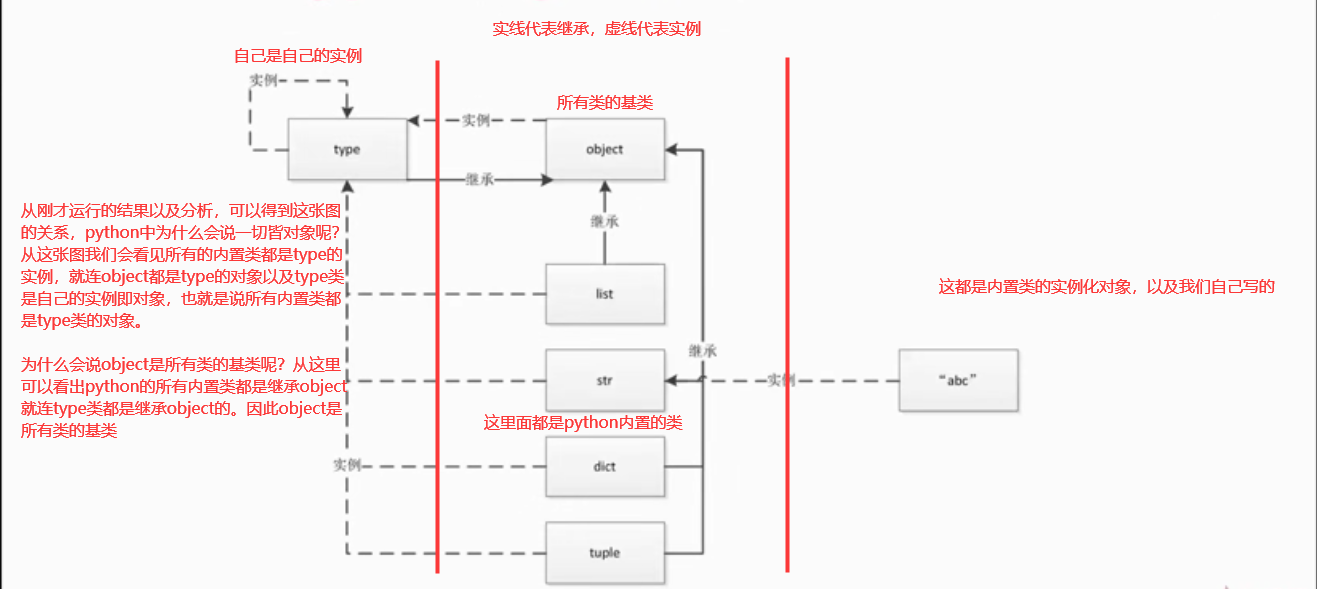python一切皆对象
Python中一切皆对象,在静态语言中,Java也是面向对象编程,Python要比Java的面向对象编程更加彻底。元类编程以及猴子补丁都是用一切皆对象编程出来的。
1、函数和类也是对象,是Python的一等公民
1.1、赋值给一个变量
对函数操作:
def ask(name=""): print(name) my_func = ask #函数对象赋值给变量,然后我们对变量的操作就是对函数的操作 my_func("lishuntao")
对类操作:
class Person: def __init__(self): print("lishuntao") my_class = Person #类对象赋值给变量,然后我们对变量的操作就是对类的操作
my_class()
1.2、可以添加到集合对象中
def ask(name="lishuntao"): print(name) class Person: def __init__(self): print("lishuntao001") obj_list = [] obj_list.append(ask) obj_list.append(Person) for obj in obj_list: print(obj())
结果反映出了,可以将对象添加到集合中。

1.3、可以作为参数传递给函数
def ask(name="lishuntao"): print(name) def print_type(item): print(type(item)) print(print_type(ask))

1.4、当做函数的返回值
def ask(name="lishuntao"): print(name) def decorator_func(): print("start") return ask my_func = decorator_func() my_func("Intersting")

可以看见,将decorator_func函数赋值给my_func变量,由于decorator_func函数的返回值是一个函数,将返回值返回给my_func,直接可以调用my_func可以实现ask函数功能,一个函数里面是可以实现另一个函数的。这样的操作实际上就是Python中的装饰器实现的原理。
2、type、object和class之间的关系
a = 11 b = "abc" c = [1,2] d = {"a":2} class Students(): pass class MyStudents(Students): pass stu = Students() print(type(d)) # <class 'dict'> print(type(dict)) # <class 'type'> # **:type==>list==>c print(type(a)) #<class 'int'> **:type==>dict==>d print(type(int)) #<class 'type'> **:type==>int==>a print(type(b)) #<class 'str'> **:type==>str==>b print(type(str)) #<class 'type'> **:type==>Students==>object print(type(stu)) #<class '__main__.Students'> **:type==>type==>MyStudents==>Students==>object print(type(Students)) #<class 'type'> **:type类的基类是object,object的基类是空,object的类型是type类,由此可以总结出他们之间的关系 print(int.__bases__) #(<class 'object'>,) print(str.__bases__) #(<class 'object'>,) print(Students.__bases__) #(<class 'object'>,) print(MyStudents.__bases__)#(<class '__main__.Students'>,) print(type.__bases__)#(<class 'object'>,) print(object.__bases__)#() print(type(object))#<class 'type'>

3、Python中常见内置类型
3.1、对象的三个特征
身份:什么是身份呢?可以理解成对象在内存中的地址。(可以用id函数来查看对象的地址)
类型:对象都是有类型的。(例如:int型,str型)
值:
3.2、类型:Python中有哪些类型
3.2.1、None类型(全局只有一个):
Python解释器运行的时候,Python会用None这个类型声明一个None的对象。(例如:变量a、b都被赋值一个None对象,然后会发现变量都指向一个None对象(地址可以看出,例如下图))

3.2.2、数值类型:
int类型、float类型、complex(复数)类型、bool类型
3.2.3、迭代类型:
迭代类型用for循环进行遍历。(在后边的迭代器和生成器学习会介绍)
3.2.4、序列类型:
常见的有list、tuple、str、array、range、bytes,bytearray,memoryview(二进制序列)等。
3.2.5、映射类型(dict):
常用的字典,是一个映射类型。映射类型就是有key和map的。
3.2.6、集合:
set、frozenset(不可以修改的set)
3.2.7、上下文管理类型(with):
with语句
3.2.8其他类型:
模块类型(from,import)、class和实例、函数类型、方法类型(方法和函数是有区别的。方法是类中的函数)、代码类型(代码本身也会被Python解释器变为一个对象类型)、object对象、type类型、ellipsis类型(省略号类型)、notimplemented类型